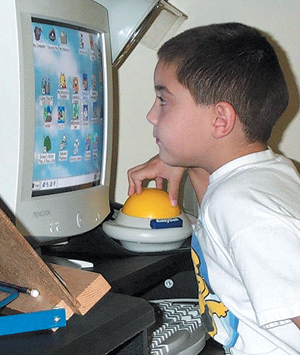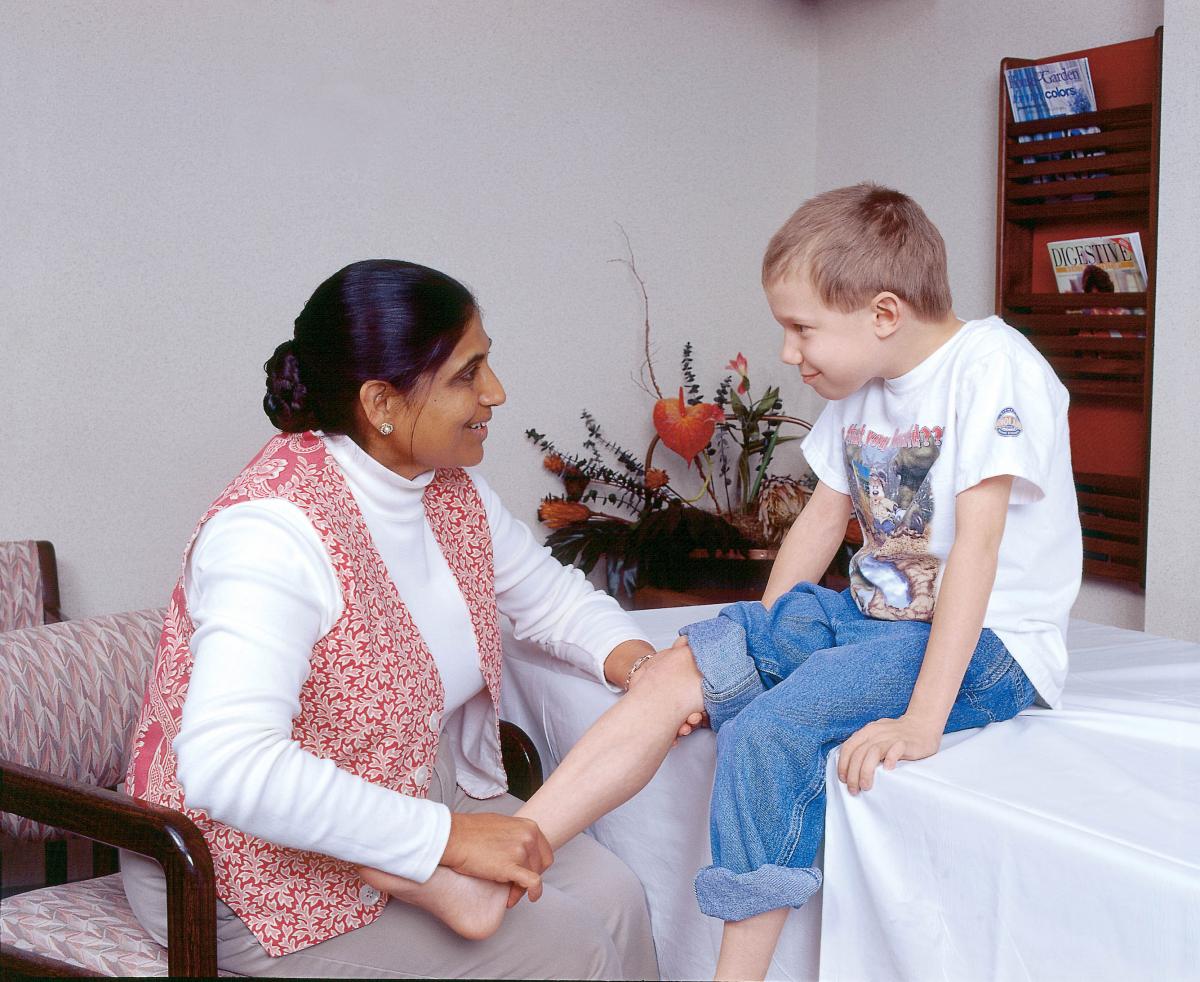Congenital Muscular Dystrophy (CMD)
Medical Management
Update (March 31, 2015): A new guideline for care and diagnosis of CMD was published by the American Academy of Neurology on March 30, 2015. See CMD: Guideline for Patients and Familes.
In December 2010, an international panel of doctors and scientists, including many supported by MDA, published standard of care guidelines for CMD. Although directed at physicians and other professionals, the guidelines are helpful to parents as well.
General care
The physician should meet with the family of a child with a clinical diagnosis of CMD as soon as possible, even before a specific genetic diagnosis is made. The first meeting with the family should include the following five components: diagnosis, prognosis, recurrence risk (if known), treatment plan, and family support and community resources.
The treatment plan should introduce a multidisciplinary approach and include pulmonologists, cardiologists, ophthalmologists, physiotherapists, orthopedists, possibly others, and ideally, a palliative care specialist to optimize quality of life.
A follow-up visit with a genetic counselor may be in order, but since 50 percent of children with CMD may not have a specific genetic diagnosis, supportive care should take place regardless of whether or not a specific genetic diagnosis is made.
To learn more, see:
- Who's Who on the Health Care Team?
- MDA Genetic Counseling Webinar Answers Key Questions
- New Guidelines on Genetic Testing in Children
Cardiac (heart) care
Some types of CMD, such as merosin-deficient CMD, are associated with severe cardiac complications. Since undetected heart problems can worsen over time, the guidelines recommend that everyone undergo cardiac screening at the time a CMD diagnosis is made, or as soon as possible thereafter.
Cardiac investigations should be systematically performed during follow-up examinations, and the frequency of which is dependent on the type of CMD and the level of cardiac involvement. Cardiac symptoms sometimes are atypical, especially in younger patients, and can start late in the course of the disease.
Since severe heart arrhythmia can lead to sudden death, implantation of a defibrillator should be considered.
To learn more, see Revising Cardiac Care in Muscular Dystrophies.
Gastrointestinal, nutritional and oral care
Feeding and swallowing difficulties are significant problems in some types of CMD. Individuals with this problem should be observed and evaluated by a qualified specialist, using a video-fluoroscopic swallow assessment, if possible.
Recommendations for the treatment and management of feeding problems include adaptations to positioning and seating, supports for self-feeding, safe swallowing techniques and food texture modification.
If these recommendations are insufficient, gastrostomy tube feeding should be considered.
Muscle weakness and facial malformation can lead to speech problems in some people with CMD. There is no evidence that oral motor therapy and exercises help improve speech, but they may help resolve feeding problems.
To learn more, see:
- 'I Can Eat That!' Cookbook for Easy Chewing and Swallowing
- Coping with Neuromuscular Disease in Infants
- Profile: Hoping for a Miracle but Taking What Comes
- Sorting Out Speech Services
Neurological issues
 Problems related to congenital brain malformation, which occurs in some forms of CMD, include behavioral and learning problems, autistic features, emotional problems, seizures and vision problems. The Standard of Care discusses various medications for seizures and recommends that neurologists act as advocates to obtain the best possible professional and community supports and services for the child with CMD-related mental and emotional issues.
Problems related to congenital brain malformation, which occurs in some forms of CMD, include behavioral and learning problems, autistic features, emotional problems, seizures and vision problems. The Standard of Care discusses various medications for seizures and recommends that neurologists act as advocates to obtain the best possible professional and community supports and services for the child with CMD-related mental and emotional issues.
To learn more, see:
- How to Get Your Child’s School to Provide Assistive Technology or Help with Learning Disabilities
- Congenital MDs: Brain abnormalities (part of the larger article When Neuromuscular Disease Affects the Brain)
Specially adapted computers also can help children with vision problems.
Orthopedics and rehabilitation
Orthopedic symptoms, such as joint contractures, scoliosis, foot and spine deformities, rigid spine, hip dislocation and joint hypermobility are some of the most common aspects of CMD.
A conservative and preventive approach to orthopedic symptoms is recommended. Regular stretching, maintaining proper positioning and environmental supports such as braces and orthotics are generally favored over surgical interventions.
Although spinal surgery has been shown to improve the quality of life of older children with progressive spinal deformity, great care should be taken to minimize the risks of surgical intervention; postoperative, multidisciplinary care is essential.
To learn more, see:
- Cushion Comfort: The right cushion makes all the difference in wheelchair comfort
- In Focus: Straightening the Growing Spine
- Adapting to Change After Spinal Surgery
- Straightening the Growing Spine (video)
- Front, Middle or Rear? Finding the Power Chair Drive System That's Right for You
Palliative care
 Palliative care seeks to incorporate the emotional, spiritual, developmental and physical aspects of caring for a person with a life-threatening disease. It is a comprehensive and multidisciplinary model that benefits patients, caregivers and practitioners as they seek to maximize the life span and well-being of the person with CMD.
Palliative care seeks to incorporate the emotional, spiritual, developmental and physical aspects of caring for a person with a life-threatening disease. It is a comprehensive and multidisciplinary model that benefits patients, caregivers and practitioners as they seek to maximize the life span and well-being of the person with CMD.
Problems that can be addressed through palliative care include fatigue, pain, depression, anger, anxiety, and other mental and emotional difficulties.
Established inpatient and outpatient palliative care resources should be offered, although other members of the medical team also may act as palliative care specialists.
Unclear diagnoses and uncertain prognoses are common features of CMD, requiring well-coordinated multidisciplinary care and strong patient-provider relationships throughout the changing course of the disease.
To learn more, see:
- The International Heartsongs Project
- Fatigue
- Shy Kids with Disabilities: To Push or Not to Push?
- Coping with Neuromuscular Disease in Infants
Respiratory care
All types of CMD can lead to the development of respiratory failure, and in some types, breathing problems may be severe from birth.
A proactive approach is favored because breathing problems can be present before they become noticeable. Weak crying, ineffective cough, choking on feedings, weight loss and repeated infections all can be signs of respiratory distress, even though, because of motor weakness, typical signs like breathlessness may not be present.
The guidelines address how to accurately assess and monitor breathing problems in children and adults with CMD and recommend that noninvasive ventilation be offered, particularly at night, before respiratory distress becomes acute.
Aggressive treatment of acute respiratory tract infections is particularly important, as these infections are the most common cause of hospital admissions and death in people with CMD.
To learn more, see:

